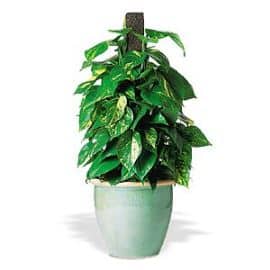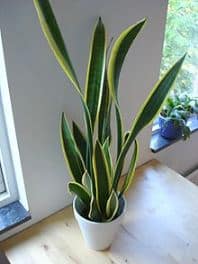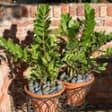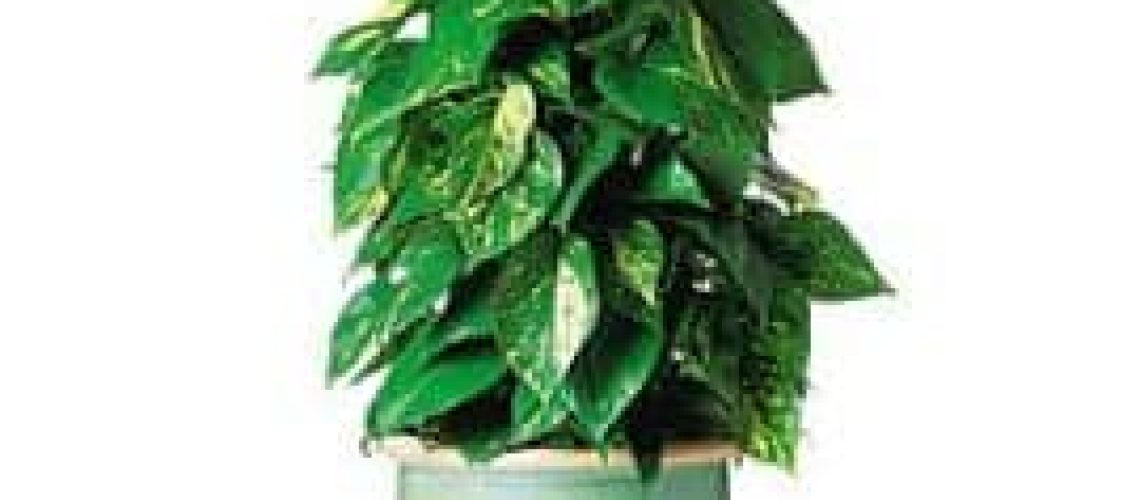Having indoor plants has always been a desire of mine. Not only do they look beautiful, they also improve indoor air quality. However, my lack of “green thumb” proves to be dangerous for any plant that would dare be brought through my doors. I eagerly volunteer to watch my friends dogs but adamantly refuse to plant sit for fear of the final outcome. I recently found some plants that are considered to be durable for indoor landscaping scenarios. They are as follows:
 1. Variegated Philodandron/Pothos
1. Variegated Philodandron/Pothos
Botanical name: epipremnum aureum
This is considered to be one of the most durable house plants to have. One of its other common names is Devil’s Ivy. It has long traily vines which makes a great plant to cover a larger area like a plant shelf or a table top. It’s a great plant for city living because it’s hardy, doesn’t require a lot of light and can handle erratic watering. The pothos is a common plant used to purify indoor air.
 2.Sansevieria/Snake Plant
2.Sansevieria/Snake Plant
Botanical name: Sanservia trifasciata
This is a flowering plants also known as Devil’s tongue or Mother-In-Law’s tongue. It’s an easy to grow, easy to care for plant. It can survive in an environment of high sunlight but also does well in rooms that have lower light levels. It survives in most temperatures but prefers warmer climates. This plant can handle a lot or a little bit of moisture. Sounds like its all the way around adaptable house plant for a novice grower with a busy lifestyle.
 3. Zanzibar Gem/ZZ Plant
3. Zanzibar Gem/ZZ Plant
Botanical name: Zamioculcas zamiifolia
Jokingly called the cockroach of landscape materials. It can outlive most humans. It’s a great indoor plant because in thrives in almost any condition. This tropical perennial resists disease and pests. It doesn’t require a lot of light and actually prefers its soil to remain dryer. Perfect for the plant owner that doesn’t remember to water plants regularly. At maturity it can grow 4-5′ H and can reach a width of 3-4′.
4. Schefflera/Gold Capella
Botanical name: Schefflera arbriocola
This indoor plant is a great investment. It’s easy to care for and lasts a long time. The typical indoor height is 3′ but has been known to grow upwards of 8′ H. When it gets this large it can safely be transplanted outdoors. It requires medium to bright light and needs to be regularly watered although you need to be careful not to saturate the soil. It absorbs nasty toxins and is especially good for a house that has a smoker. This is a common plant you see in silk versions in offices.
5. Pony Tail Palm
Botanical name: Beaucarnea recurvata
This is a low maintenance palm with whimsical, ribbon like fronds that resemble a pony tail. It’s popular for indoor containers or as an outdoor in the ground landscaping addition. It can handle light shade to full sunlight. It can survive long spells of drought. It’s slow growing, rarely reaching 10′ indoors although outdoors it has been know to grown up to 20′ H. If it grows too large indoors it perfectly safe to transplant it into your outdoor landscaping.
6. Chinese Evergreen/Silver Queen/ Emerald Beauty
Botanical name: Aglaonema modestrum
This is a great plant for beginners. A typical size for this indoor plant is 12 – 36″ H and 12 – 24″ W. It’s a member of the aracea family and is best suited for tropical environments. This is a great plant for indoor atriums, offices, and other hot indoor settings. It doesn’t like direct sunlight, loves a humid climate, the warmer the environment the better for this plant. It cleans the air ridding it of toxins like toluene and xylene both of which are additives found in gas, paint, adhesives, cleaning supplies and more. This would be a wonderful addition to any nail salon.
With this arsenal of durable indoor plants the “black thumbs” of the plant world can now feel confident that they will be able to have landscaping for their indoor environment that will survive our lack of botanical talent.


